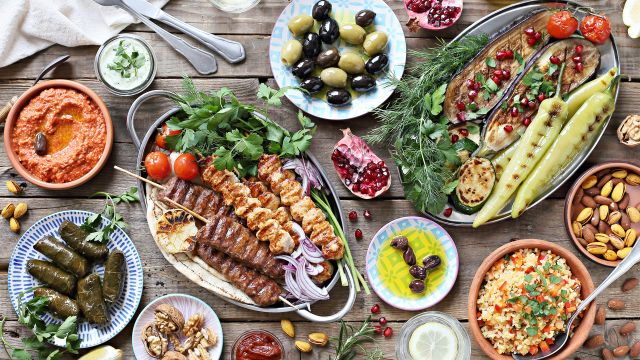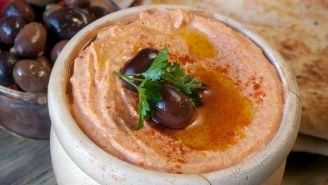Updated on January 5, 2024.
Built largely upon plant-based foods, lean proteins, and healthy fats, the Mediterranean diet is often touted as one of the healthiest ways to eat. No wonder it perennially lands atop U.S. News & World Report's list of outstanding diets.
Research links the eating style to a multitude of benefits, including a lower risk of several conditions, including:
- Heart disease, heart attack, and stroke
- High blood pressure
- High cholesterol
- Obesity
- Type 2 diabetes
- Parkinson’s disease
- Rheumatoid arthritis
- Alzheimer’s disease
- Certain types of cancer
The problem is, many of us believe that eating a healthy diet costs too much. For example, in a 2023 national survey conducted by the Cleveland Clinic, about 46 percent of those polled thought healthy foods were more expensive than other foods.
It’s true that the prices of some wholesome, nutritious items are generally higher. But spending extra dollars over time on healthy eating is a bargain compared to the cost of managing chronic conditions related to a poor diet, such as diabetes, cardiovascular disease, and cancer.
Fortunately, there are ways to stretch your food dollar right now—and dish up delicious and healthy meals in the process.
What to eat on the Mediterranean diet
The Mediterranean diet is not new or a fad. It’s how people in countries bordering the Mediterranean Sea have been eating for generations, says Alyssa Stacey, RD, a registered dietitian in Salt Lake City. At its core, Stacey says, the eating style is actually quite simple to follow.
The diet’s foundation is fruits and vegetables, whole grains, nuts, beans, and healthy fats like olive oil. This is what you eat every day. Fish, poultry, eggs, and dairy products can be enjoyed a few times weekly in moderate amounts. Sweets and red meat are “sometimes” foods. Meat, poultry, and fish aren’t necessities; the diet can be vegan or even vegetarian.
Mediterranean eating doesn’t have to be fancy or complicated, Stacey explains. Peanut butter smeared on whole-grain bread fits the bill. So does a simple whole-grain pasta tossed with pesto and roasted tomatoes.
How to go Mediterranean on a budget
You can eat like a Mediterranean without breaking the bank. Here’s how:
Shop in season. Produce is generally more affordable when you buy it in season. For example, in most of the United States, watermelons, tomatoes, and peaches are cheapest in summer when they’re plentiful and at their peak. If you’re not sure about best buys, ask the produce manager at your grocery store.
Another option: Shop your local farmer’s market or food co-op for in-season and locally grown produce. For a true harvest-to-table experience, plant your own garden.
Minimize waste. Don’t let fresh veggies go bad sitting in your refrigerator. Look through cookbooks and websites for recipe ideas or try different preparations to help use them up. For instance, if you can’t eat all your spinach within a week, Stacey suggests stirring it into a Friday night soup or cooking and freezing it for later.
Be choosy about organic foods. Organic produce is grown without the chemical pesticides and fertilizers used in conventional farming. It’s generally more expensive than non-organic food. You don’t have to eat organic on the Mediterranean diet, though, so if it’s not in your budget, don’t stress.
“I’m concerned more about food safety and less worried about organic,” Stacey says. She recommends washing all fruits and veggies well to remove pesticide residue, dirt, and bacteria.
Be ‘canny.’ Canned fruits and vegetables are convenient pantry staples with long shelf lives. Sodium is often used for their preservation, so choose low- or reduced-sodium products and look for “no salt added” on labels. Buy fruit packed in water or in its own juice. Drain and rinse veggies and do the same for fruit if it’s packed in syrup.
Shop the frozen aisle. Frozen fruits and veggies are typically picked and packed at peak ripeness, which helps retain their vitamins and minerals, Stacey says. Try your store brand and keep your eyes peeled for coupons or specials to stock up. Again, look for products with the least sodium and little-to-no added sugar.
Be fish-savvy. Fish and seafood are stars of the Mediterranean diet. Fattier fish like salmon, mackerel, and lake trout are good sources of heart-healthy omega-3 fatty acids. Whiting and tilapia are usually lower-cost options and solid sources of protein.
More economical options include frozen fish and fish packed in cans or pouches. Tuna, salmon, and sardines are reliable choices, Stacey says. Keep your portions to around 3.5 ounces or about the size of your palm. The American Heart Association recommends eating fish at least twice per week.
Eat eggs. Try an omelet with veggies or add a chopped hard-boiled egg to your next tossed salad. Eggs are packed with protein, low in calories, and can replace red or processed meat in your diet. The do contain cholesterol, but experts believe that it has little effect on blood cholesterol levels. For most people, an egg a day won’t raise the risk of cardiovascular disease.
Ask your healthcare provider about how many eggs you can safely eat if you smoke or have other risk factors for cardiovascular disease or if you have diabetes or heart disease already.
Go meatless. Pick a day or two each week to eat vegetarian. Beans are cheap, whether they’re dried or canned and can add needed protein and fiber to your diet. Bean, corn and pepper salad is a tasty Mediterranean-style option, great for lunch or light dinners.
Spice things up. Many Mediterranean-style dishes call for a heavy dose of herbs and spices, but seasonings can add to your grocery bill. You can typically save on an ounce-for-ounce basis when you buy larger containers.
When you buy herbs in the produce aisle, it can often be difficult to use them up while they’re still fresh. To preserve your investment, add chopped leftovers to some olive oil and freeze in ice cube trays for use at a later date.
Purchase in bulk. Join a warehouse club and buy large quantities of nuts, olive oil, produce, and more. Share with a friend to offset the costs, especially if it’s food that could spoil.
A word about what to drink
As you’ve probably heard, wine can be part of the Mediterranean diet, but it’s not required. If you choose to imbibe, do so in moderation and with meals. That means no more than one 5-ounce glass per day for women and two for men. Drink water throughout the day, as well.
Finally, keep in mind that the Mediterranean way of life is about more than what you put in your mouth. It’s an entire lifestyle. Stay active on most days and take time to keep your social connections strong. Leisurely meals shared with family and friends not only feed your belly, they also nourish your soul.







